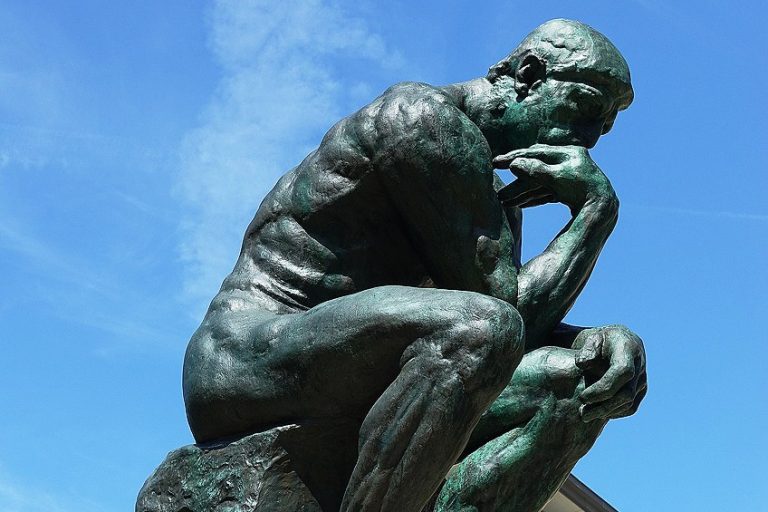Michelangelo Sculptures – Explore the Famous Michelangelo Works
I saw the angel in the marble and carved until I set him free.” This quote is from Michelangelo di Lodovico Buonarroti Simoni, more commonly known as Michelangelo, who is one of the most well-known and influential figures in art history. He was an Italian painter, sculptor, architect, and poet of the High Renaissance period. His work was especially notable for its significant influence on the development of the Western tradition of art, particularly with regard to the notions of humanism and naturalism that were common amongst artists and scholars at the time. The Renaissance cultural revival of classical Greek and Roman art is evident in Michelangelo’s work, but what made his pieces especially captivating was his use of emotional realism and psychological intensity. This article introduces some of Michelangelo’s most well-known sculptures, their histories, and interpreted meanings.
Table of Contents
- 1 Famous Sculptures by Michelangelo
- 1.1 Crucifix (1492)
- 1.2 Angel (1494 – 1495)
- 1.3 Bacchus (1496 – 1497)
- 1.4 Pietà (1498 – 1499)
- 1.5 David (1501 – 1504)
- 1.6 Madonna of Bruges (1501 – 1504)
- 1.7 Rebellious Slave (1513)
- 1.8 The Moses (1513 – 1515)
- 1.9 Dying Slave (1513 – 1516)
- 1.10 Apollo (1530)
- 1.11 Crouching Boy (1530 – 1534)
- 1.12 The Genius of Victory (1532 – 1534)
- 1.13 Rachel (1542 – 1545)
- 1.14 The Deposition (1547 – 1553)
- 1.15 Cupid (1556)
- 2 Frequently Asked Questions
Famous Sculptures by Michelangelo
Some of the most well-known and famous Michelangelo works are his Renaissance Sculptures. These Michelangelo works not only show the artist’s great skill, but also tell their own stories, and have their own histories. Here are 15 of the most renowned Michelangelo sculptures.
Crucifix (1492)
| Title | Crucifix |
| Date Created | 1492 |
| Medium | Polychrome Wood statue |
| Dimensions (cm) | 142 x 35 |
| Current location | Santo Spirito, Florence |
| Value | 4.2 million |
Michelangelo created this piece at the age of 18, as a token of appreciation to the Augustine monks at San Spirito who provided him housing. The subject of the statue, a crucified Jesus on the cross, was rather common in art, the subject matter of many sculptures and paintings.
This sculpture did not give Michelangelo’s career as an artist much attention, with most forgetting that he was the one who created it.

In Vasari’s The Lives of the Artists (1908), it is said that Michelangelo began to study anatomy by dissecting corpses at San Spirito, which helped greatly in his future works. The statue has been described as juvenile, with Christ not having the iconic muscular physique Michelangelo is well-known for. It is likely, however, that this was meant to please the wishes of the commissioner.
The statue also features a spear wound on Christ’s side, as well as blood dripping down his body, from when he was stabbed by a Roman soldier, as described in the Biblical story.
Angel (1494 – 1495)
| Title | Angel |
| Date Created | 1494 – 1495 |
| Medium | Marble sculpture |
| Dimensions (cm) | 51.5 |
| Current location | Basilica of San Domenico, Bologna |
| Value | Unknown |
This marble Michelangelo statue, depicting a kneeling youthful angel holding a candlestick, is one of the earliest works of Michelangelo. This piece was commissioned by the Arca di San Domenico in Bologna, where it can still be found, as a companion piece to a similar angel statue by Nicollo dell’ Arca.
While Nicollo dell’ Arca’s angel is presented as a delicate, soft, and effeminate youth dressed in Gothic robes, Michelangelo’s “Angel” is presented as strong, with the wings of an eagle, with the artist’s signature musculature.
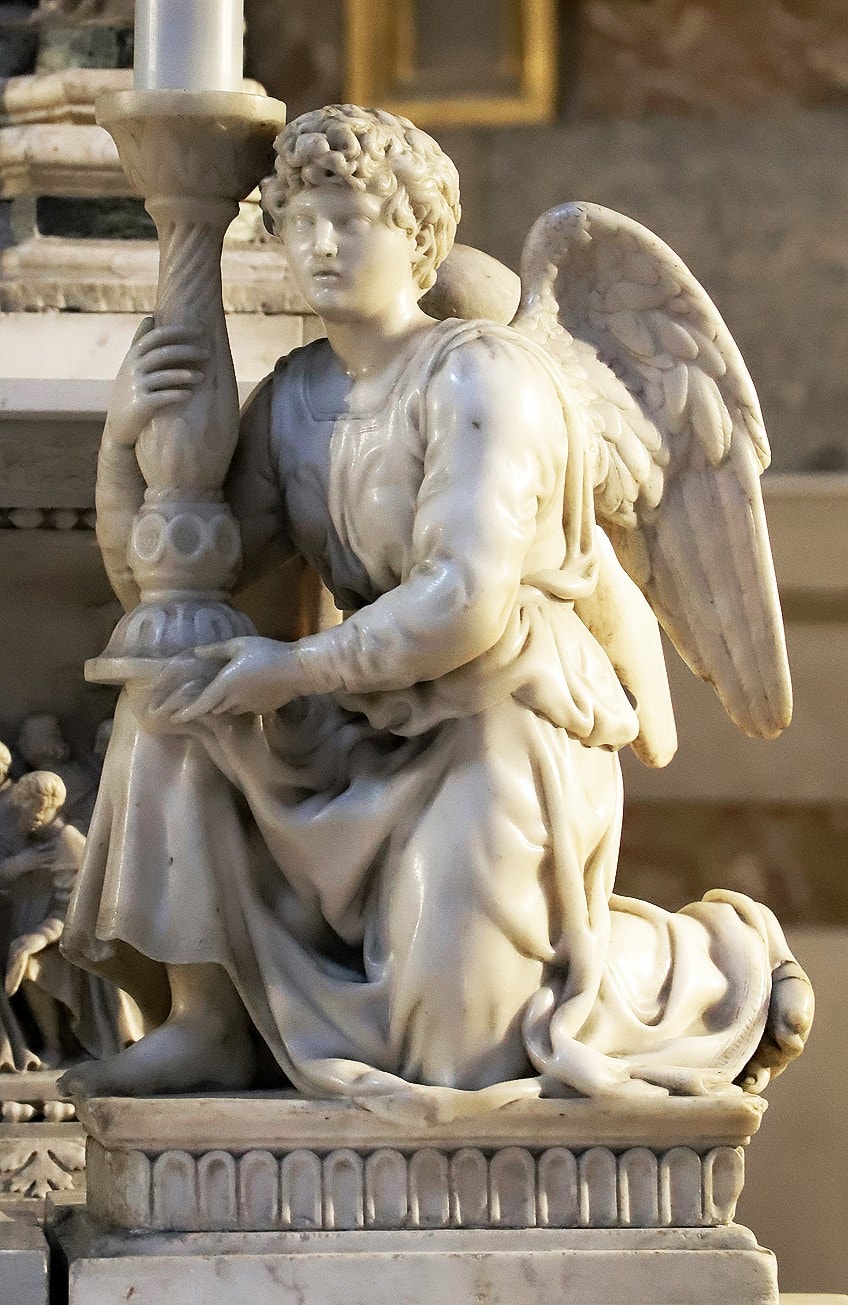
There is an essence of honor and integrity in this angel, with the contours of the sculpture communicating a sense of steadiness, with the silhouette of the piece perfectly contrasted with the backdrop of the ornate shrine it was designed to fit into.
Bacchus (1496 – 1497)
| Title | Bacchus |
| Date Created | 1496 – 1497 |
| Medium | Marble sculpture |
| Dimensions (cm) | 203 x 76 |
| Current location | Museo Nazionale del Bargello, Florence |
| Value | Unknown |
Bacchus is one of the few religious Michelangelo works that depict a Pagan subject, rather than a Christian. The statue, which was originally commissioned by Cardinal Raffaele Riario, who ended up rejecting it after finding the finished product to be inappropriate, depicts the Roman god of wine, Bacchus (known as Dionysus in Greek mythology) in a pose of suggestive drunkenness. The god’s eyes are rolling upwards, his body positioned in a way that suggests staggering or swaying. He wears an ivy wreath and holds a goblet in his right hand, which he is putting up to his lips for another sip.
He holds the skin of a lion in his other hand, which symbolizes death. This symbolism is derived from the Greek myth of Hercules.
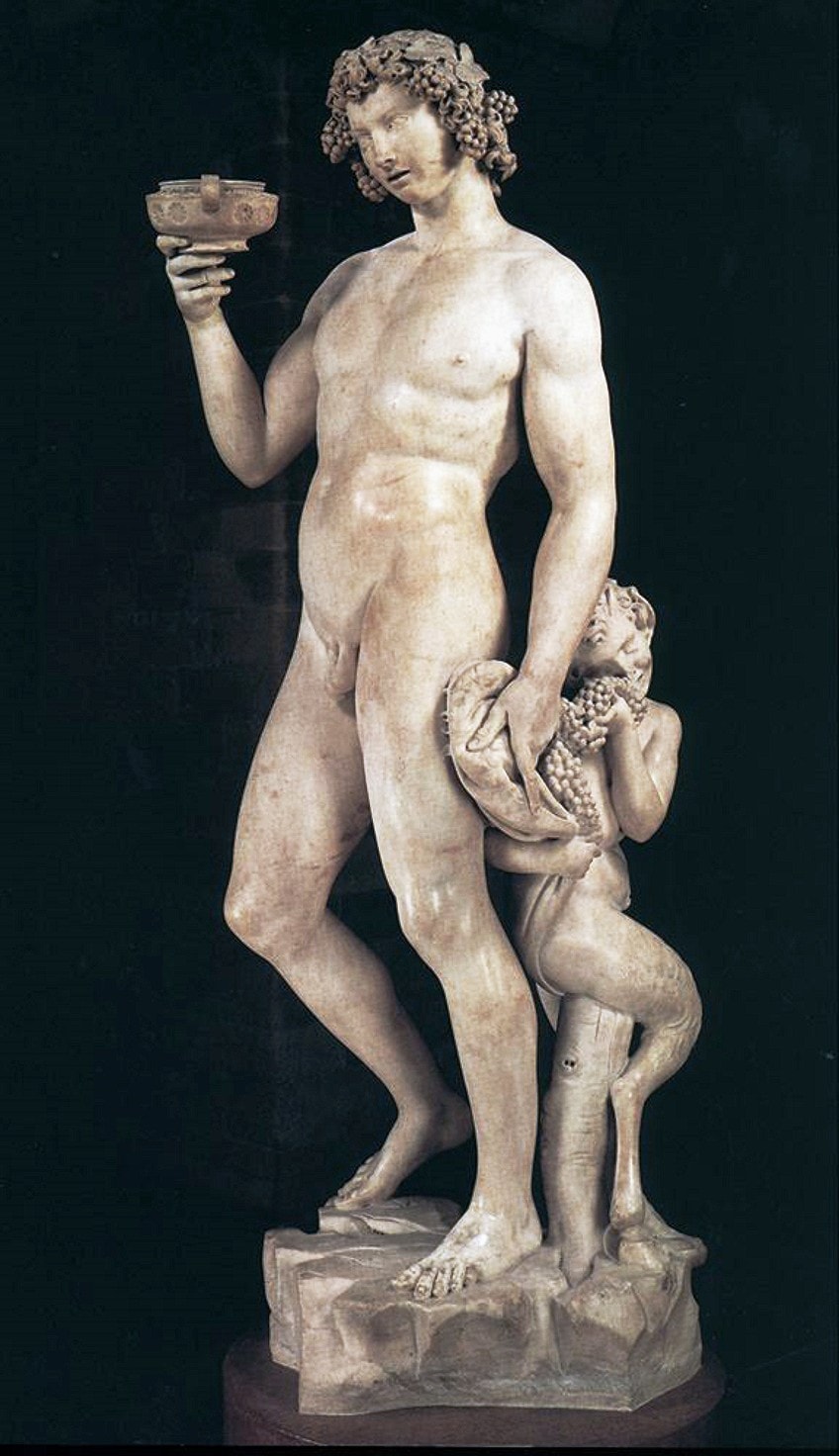
Michelangelo’s use of anatomy depicts the god as almost androgynous, with Giorgio Vasari describing it with “both the slenderness of a young man and the fleshiness and roundness of a woman”, which fits the description of the god from Pliny the Elder’s Natural History (77 AD) manuscript of a lost bronze sculpture by Praxiteles. Behind the god stands a small satyr, or faun, as it is known in Roman mythology, eating the grapes falling from the god’s careless hand.
The usage of a faun is significant in that the deity was the symbol for the Cult of Bacchus.
Pietà (1498 – 1499)
| Title | Pietà |
| Date Created | 1498-1499 |
| Medium | Carrara marble sculpture |
| Dimensions (cm) | 174 x 195 |
| Current location | St. Peter’s Basilica, Vatican City |
| Value | $300 million |
This Michelangelo sculpture was the first of many pietàs created by the artist, depicting the Biblical scene in which the Virgin Mary cradles Jesus after being crucified, otherwise known as a pietà. While this scene was commonly depicted in European art, it was not as common in Italy, and Michelangelo’s work was the first time the scene had been presented using the medium of a marble statue. During the Renaissance era, many artists began to translate religious narratives into a more humanist representation, blurring the lines between man and the divine.
This can be seen in Michelangelo’s piece, with the Virgin Mary being presented in a much more human, maternal manner than the traditional Madonna representation.
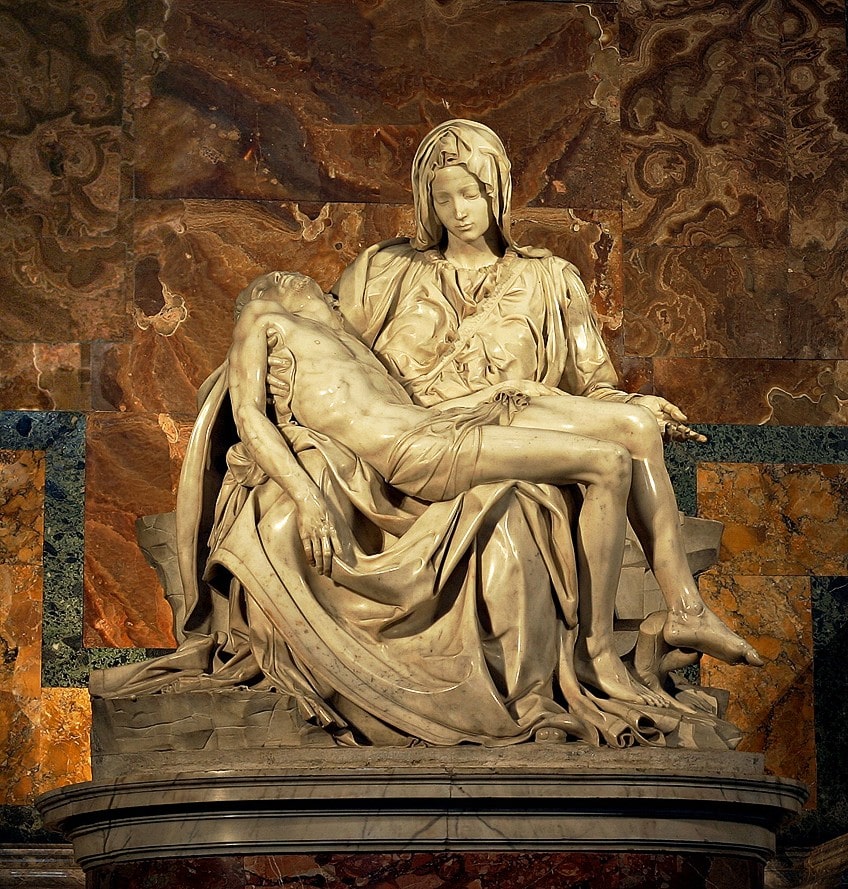
Michelangelo presented her as younger than most artists tended to, and rather than depicting her suffering, presented her as a mother with deep maternal tenderness for Christ, who shows very little signs of the recent crucifixion, rather looking asleep in the arms of his mother, who waits for him to wake, which alludes to the resurrection. The composition of the statue is presented in a pyramidal structure, with Mary’s head at the top, and the gradual widening towards the base.
Interestingly, this is the only work Michelangelo ever signed, with the name Michael Angelus written across the sash which covers the breast of Mary. The use of this name references Michael the Archangel.
David (1501 – 1504)
| Title | David |
| Date Created | 1501-1504 |
| Medium | Marble statue |
| Dimensions (cm) | 517 x 199 |
| Current Location | Academia di Belle Arti di Firenze, Florence |
| Value | $200 million |
The Statue of David is in no doubt, the most well-known Michelangelo statue, and one of the most widely known works of the Renaissance era. The sculpture was a commission from the Opera del Duomo for the Cathedral of Florence and was intended to be part of a series of sculptures of prophets for the rooftop of the Church.
The statue was sculpted using a block of marble that another artist had already begun carving for a different project, who abandoned the piece after finding the marble structurally compromised. Michelangelo, however, was skillful enough to work with the stone, completing the work when he was 26 years old.

This statue represents the prophet David from the well-known Biblical story of David and Goliath. The nude statue, despite the subject, stands tall, confident, and majestic, with the slingshot he uses to kill Goliath hanging over his left shoulder. Michelangelo’s skill in anatomy is evident in David’s muscular physique, with his classical contrapposto stance, emphasizing his strength.
This confidant stance, as well as the determined look on David’s face, conveys a sense of naturalism.
Madonna of Bruges (1501 – 1504)
| Title | Madonna of Bruges |
| Date Created | 1501 – 1504 |
| Medium | Marble Sculpture |
| Dimensions (cm) | 200 x 64 |
| Current location | Onze Lieve Vrouwekerk, Bruges |
| Value | Unknown |
This grand Renaissance sculpture by Michelangelo represents the solemn attitude with which the artist often portrayed the Virgin Mary and Christ. This is the only sculpture by the artist that left Italy during his lifetime, donated to its current home in 1514. This sculpture was carved from a large and dense single slab of marble stone, which is reflected in the sturdy composition of Mary and the young Christ.
Michelangelo’s portrayal of the Madonna and child differs greatly from the earlier and contemporary depictions, which usually featured Mary smiling down at her baby, cradled in her arms.
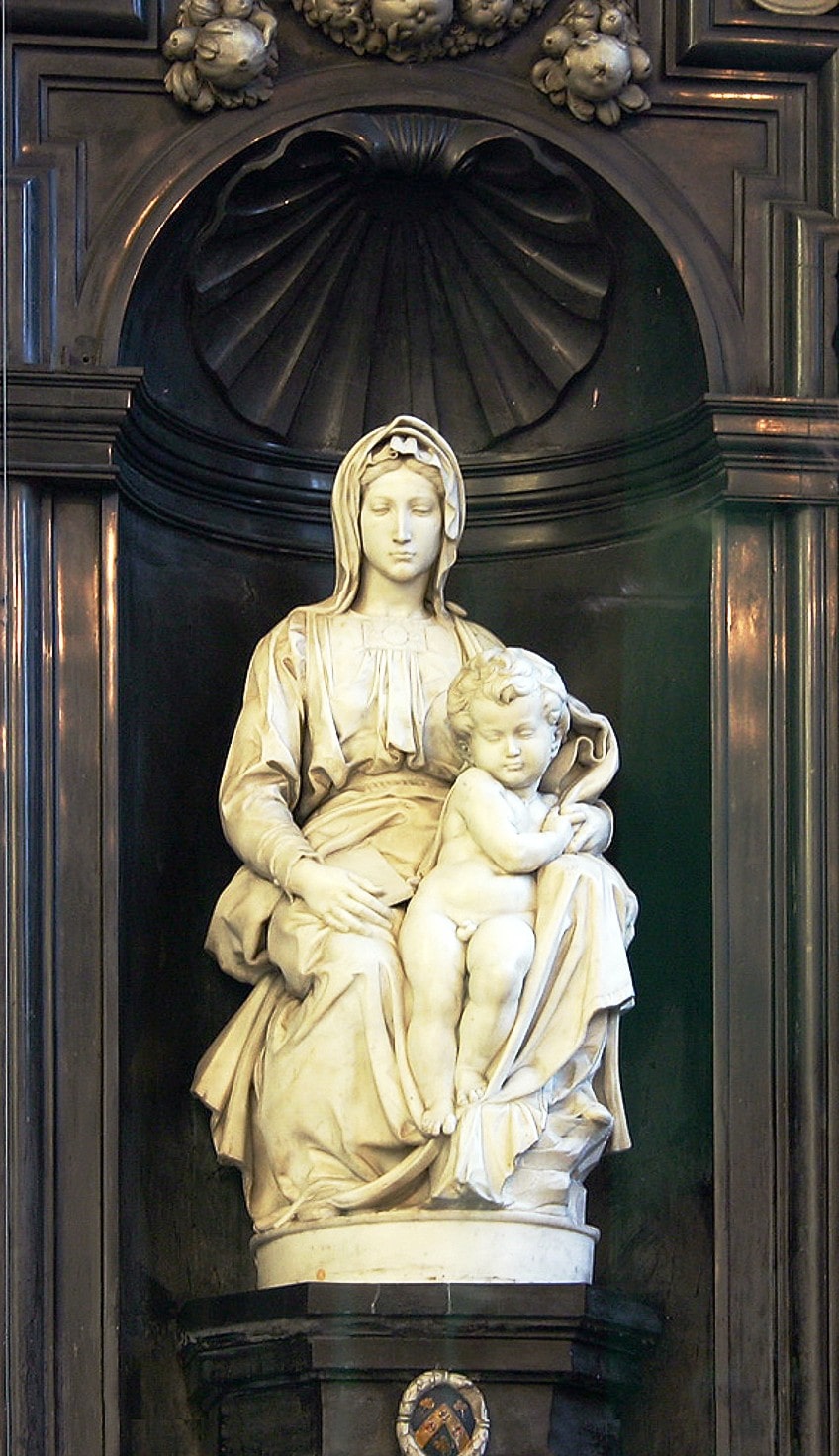
Michelangelo’s sculpture features the young Christ standing up, as if about to walk away from his mother, symbolic of him going out into the world. His mother does not restrain him, aware of her son’s divine fate.
There are similarities between this piece and Michelangelo’s “Pietà” (which he completed shortly before this piece. The use of shadows creates a chiaroscuro pattern, seen in the way in which Mary’s clothing flows and the long oval face of the Virgin.
Rebellious Slave (1513)
| Title | Rebellious Slave |
| Date Created | 1513 |
| Medium | Marble sculpture |
| Dimensions (cm) | 215 |
| Current location | The Louvre, Paris |
| Value | Unknown |
This Renaissance sculpture by Michelangelo depicts a slave in an active struggle, trying to free himself from the chains that hold him. The sculpture actively portrays the human resistance to slavery. Similar to the Dying Slave (1513-1516), implies the condition of enslavement, and the desperate need for escape. Michelangelo gives the impression with the use of the slave’s stance that they are moving towards the viewer, away from their owner or oppressor, by raising the right shoulder and knee, and through the contortion of the torso.
Much of the power of this piece comes from its unpolished, as if unfinished, nature.
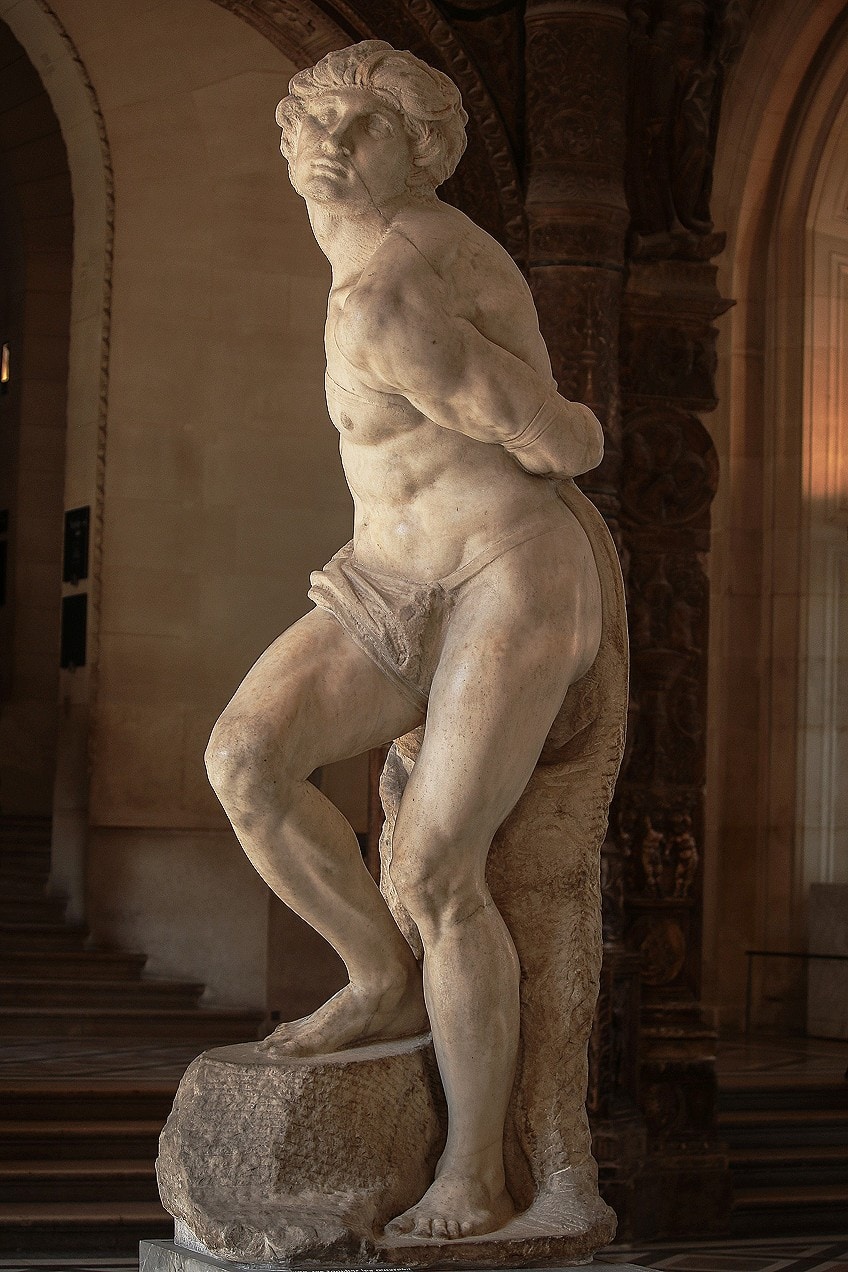
The figure’s deserted arm wound at its back expresses a steady struggle to break free. Michelangelo specifically had the figure appear to be nude to show a sense of humiliation, showing the humiliation that slaves were put through by their masters.
The sculpture’s physique is very similar to Roman models, giving a dynamic sense of authenticity.
The Moses (1513 – 1515)
| Title | The Moses |
| Date Created | 1513 – 1515 |
| Medium | Marble sculpture |
| Dimensions (cm) | 235 x 210 |
| Current location | The Church of San Pietro, Rome |
| Value | $65 million |
The Moses is one of the several Biblical Michelangelo sculptures that was commissioned, representing the scene from the Book of Exodus in which Moses comes down from Mount Sinai with the stone slabs of the Ten Commandments, to find his people worshipping a pagan idol, the Golden Calf. Moses was rather angry in this scene, and this anger is present in Michelangelo’s work; his expression is stern, and his stance, which features his left leg shifting left while his torso faces right.
This stance, along with the direction that his beard is flowing towards, creates a sense of strong movement, tension, and power. The grand statue is also notable for its use of fabric, flowing authentically.

What made this statue especially interesting is that Moses is depicted with a pair of horns. Some have interpreted this as a symbol of the prophet’s anguish, while others believe it is a literal interpretation of the Vulgate, the Latin translation of the Bible, with the Hebrew word Keren meaning either “radiated light” or “grew horns.”
Sigmund Freud noted this sculpture as “superior to the historical or traditional Moses,” believing it to have a more secular meaning, symbolic of a man repressing his passion in the interest of higher meaning.
Dying Slave (1513 – 1516)
| Title | Dying Slave |
| Date Created | 1513 – 1516 |
| Medium | Marble sculpture |
| Dimensions (cm) | 215 |
| Current location | The Louvre, Paris |
| Value | Unknown |
This piece of one of several unfinished Michelangelo sculptures meant to be for the tomb of Pope Julius II, and one of the six slave sculptures created by the artist. It was meant to accompany the sculpture, Rebellious Slave (1513), with the sculpture of Moses standing in between. The piece was made by Michelangelo after hand-selecting the perfect slabs of stone from the rock quarries of Carrara, Italy.
The artist initially planned to chisel a figure of a man in the apathetically accepting death. After the then-Pope changed his mind, canceling the commission, Michelangelo continued working on it.

The artist’s frustration with the Pope’s cancellation is evident in the piece, with the slave figure seeming frustrated by its own circumstances, with art historian Richard Fly suggesting that the slave’s struggle with death is emblematic of the artist’s struggle with the piece itself.
While the sculpture can be looked at as the slave meeting the relentless force of death, there is also a sense of distortion, frustration, and debilitation that suggest something unholy, which may reflect the context of slavery during the Italian Renaissance.
Apollo (1530)
| Title | Apollo |
| Date Created | 1530 |
| Medium | Marble sculpture |
| Dimensions (cm) | 146 cm |
| Current location | Bargello Museum, Florence |
| Value | Unknown |
Apollo, also known as Apollo-David or Apollino, was commissioned by Pope Clement VII for the palace of Baccio Valori. The sculpture depicts a nude man, variously identified as Apollo, the Greek and Roman god of the sun, and David from the Biblical story of David and Goliath. Michelangelo makes use of shadow and twisting in a way that allows multiple parts of the figure to be visible from a single angle, with both the right leg and left arm bent, with the opposite arm and leg extended.
The uncertainty regarding the identity of the subject comes from the unfinished nature of the piece. It is unknown whether the figure is meant to be drawing an arrow from a quiver, as Apollo would, or grabbing a sling, as David would.
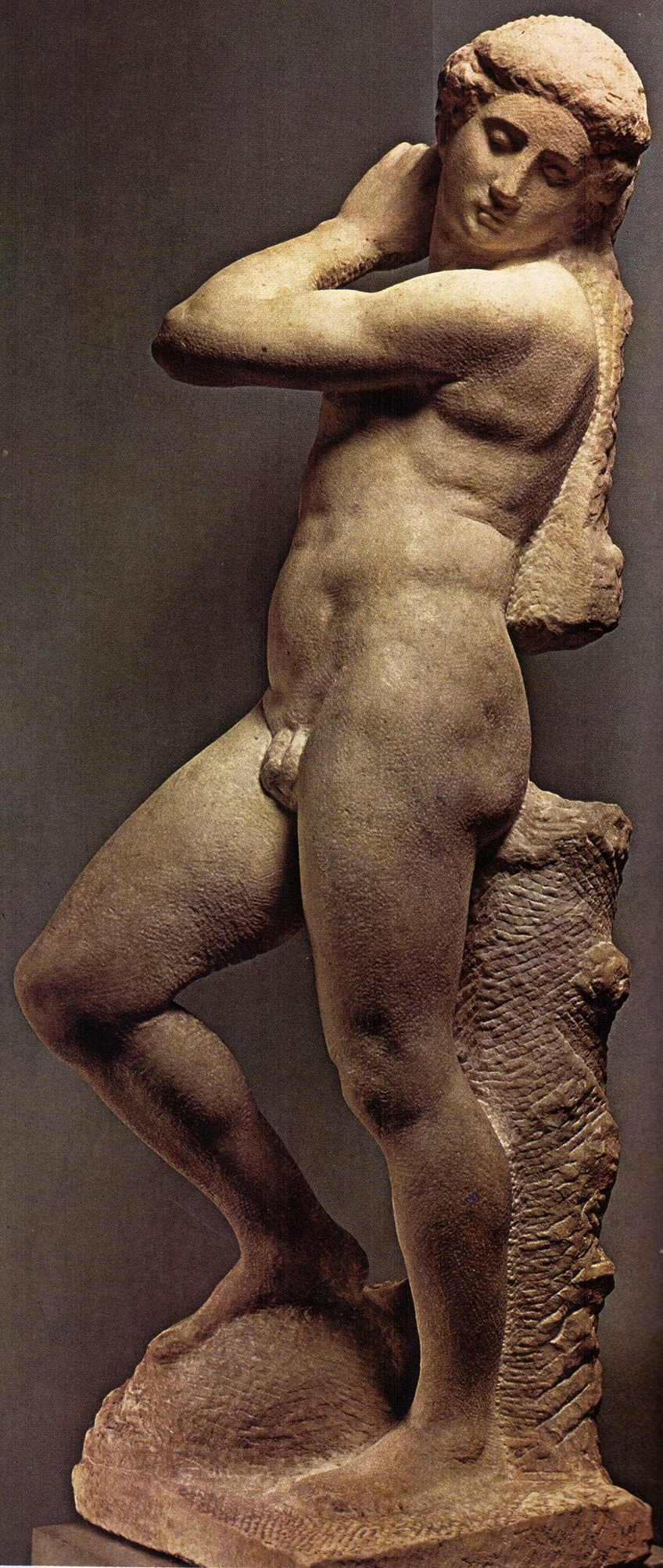
If this Renaissance sculpture by Michelangelo is meant to represent David, it is interesting when compared to the artist’s iconic David (1501 – 1504) statue, which is much more defined in its musculature and has a much less emotionally distraught expression on his face than Apollo-David.
The right foot of the figure is placed on an unfinished section, which art historians suggest could have been the head of Goliath the giant, had Michelangelo finished it and intended it to be David.
If the sculpture is meant to represent Apollo, however, the heavy-set body would be the first clue, however, there is no indication where the archer’s bow would be if added to the piece. Some art historians believe that if the sculpture is meant to depict the sun god, it would be a way for Michelangelo to express his contempt for those who conquered his home city, Caprese.
Crouching Boy (1530 – 1534)
| Title | Crouching Boy |
| Date Created | 1530 – 1534 |
| Medium | Marble sculpture |
| Dimensions (cm) | 54 x 40.3 |
| Current location | Hermitage Museum, Saint Petersburg |
| Value | Unknown |
This Michelangelo sculpture depicts a nude boy, crouching over and turning in on himself, tending to his injured foot, perhaps pulling out a thorn. The work is small and unfinished, but still features the artist’s signature well-defined physique, with his hunched-over stance suggesting inner strength compressed within.
The head of the boy is facing down as he focuses on his foot, ignoring all that goes on around him. This evokes a sense of isolation and sorrow in the piece.
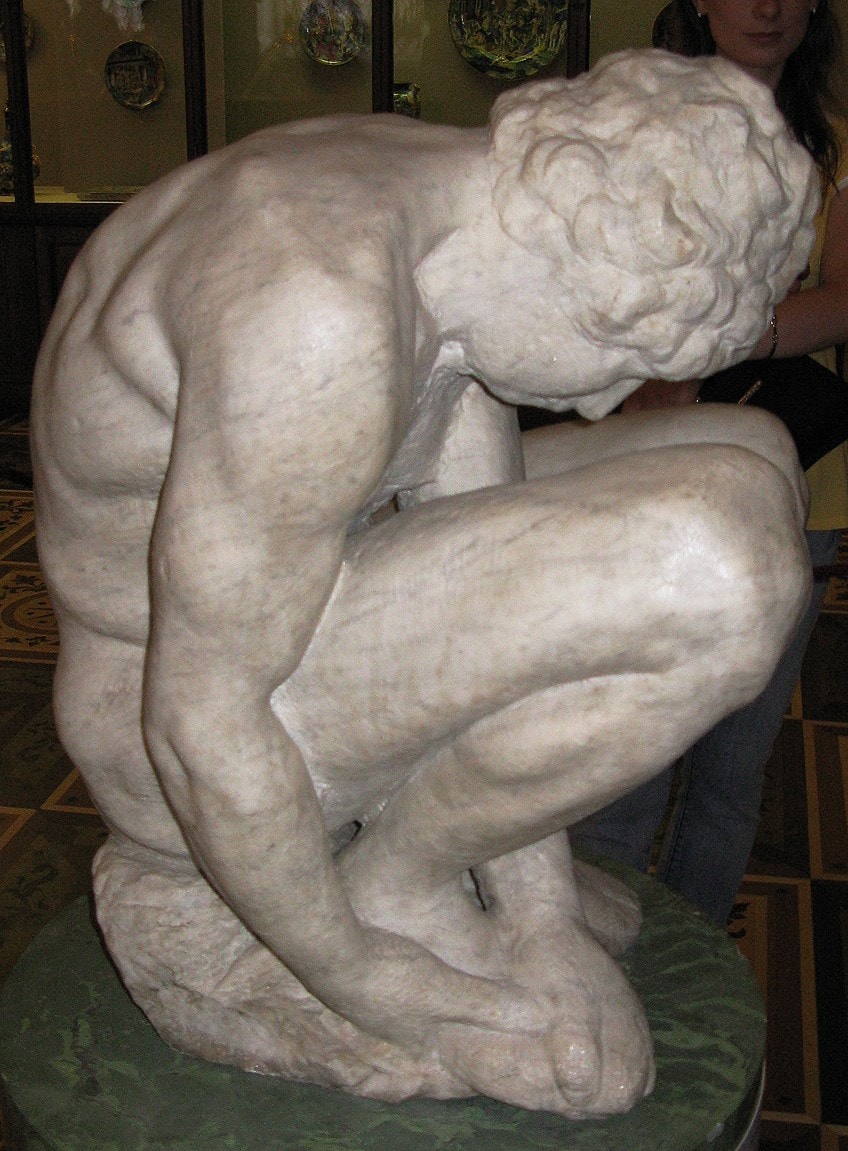
The interpretation of this piece has been a subject of debate and discussion amongst art historians, with some scholars arguing that the enigmatic piece could represent the unborn soul, with its curled, almost fetal position, while others argue it represents a wounded soldier.
Some even interpret the sculpture as the personification of genius, or even the suffering of grief or mourning.
The Genius of Victory (1532 – 1534)
| Sculpture | The Genius of Victory |
| Date Created | 1532 – 1534 |
| Medium | Marble Sculpture |
| Dimensions (cm) | 261 x 74 |
| Current location | Palazzo Vecchio, Florence |
| Value | Unknown |
The Genius of Victory, sometimes known simply as Victory, was another Michelangelo work produced for the tomb of Pope Julius II. It is generally assumed that the piece was meant to be placed there due to the strong and flowing pose of the young figure, the victor, which symbolizes the slave movement. The victor, who stands victorious over his opponent, is crowned with a laurel of oak leaves, which many scholars suggest is linked to the emblem of Della Rovere, a noble family of Italy.
The majestic sculpture evokes strength and power, representing the aftermath of a battle, with the viewer observing the victor dominating over the loser, who is trapped and chained down.
It should be noted that the victor is depicted as a young and good-looking man, while the loser is depicted as old, weak, and broken. This contrast is also present in the finish of the two men, with the victor being coated to appear smooth, while the loser is rougher, as if unfinished.
The pose of the Victor, whose arm is outstretched, pressing down on the chest of his defeated opponent. His foot is also placed over the loser, with his pose evoking strength and his twisting body only emphasizing his muscular physique. The victor’s stance creates a feeling of alertness, as if warning his opponent to not dare rise, coming off as self-assured but also arrogant in his dominance.
While many historians believe that this piece is unfinished, it has also been linked to a drawing of a winged adolescent that is located at the Casa Buonarroti, which scholars believe may be what the artist was planning to depict in the final product.
Rachel (1542 – 1545)
| Title | Rachel |
| Date Created | 1542 – 1545 |
| Medium | Marble sculpture |
| Dimensions (cm) | 209 |
| Current location | San Pietro, Rome |
| Value | Unknown |
During the Italian Renaissance, many aspiring artists were highly skilled in their craft, and during his life, Michelangelo took on many assistants, giving out tasks depending on their skills and experience. The Michelangelo statue of Rachel, as well as its companion, Leah (1542-1545), were some of the pieces the artist worked on with the help of his assistants.
“Rachel”, in particular, was sculpted by the artist, and in its later stages, was taken on by other sculptors for cleaning and polishing while Michelangelo directed, allowing him to work on other projects.
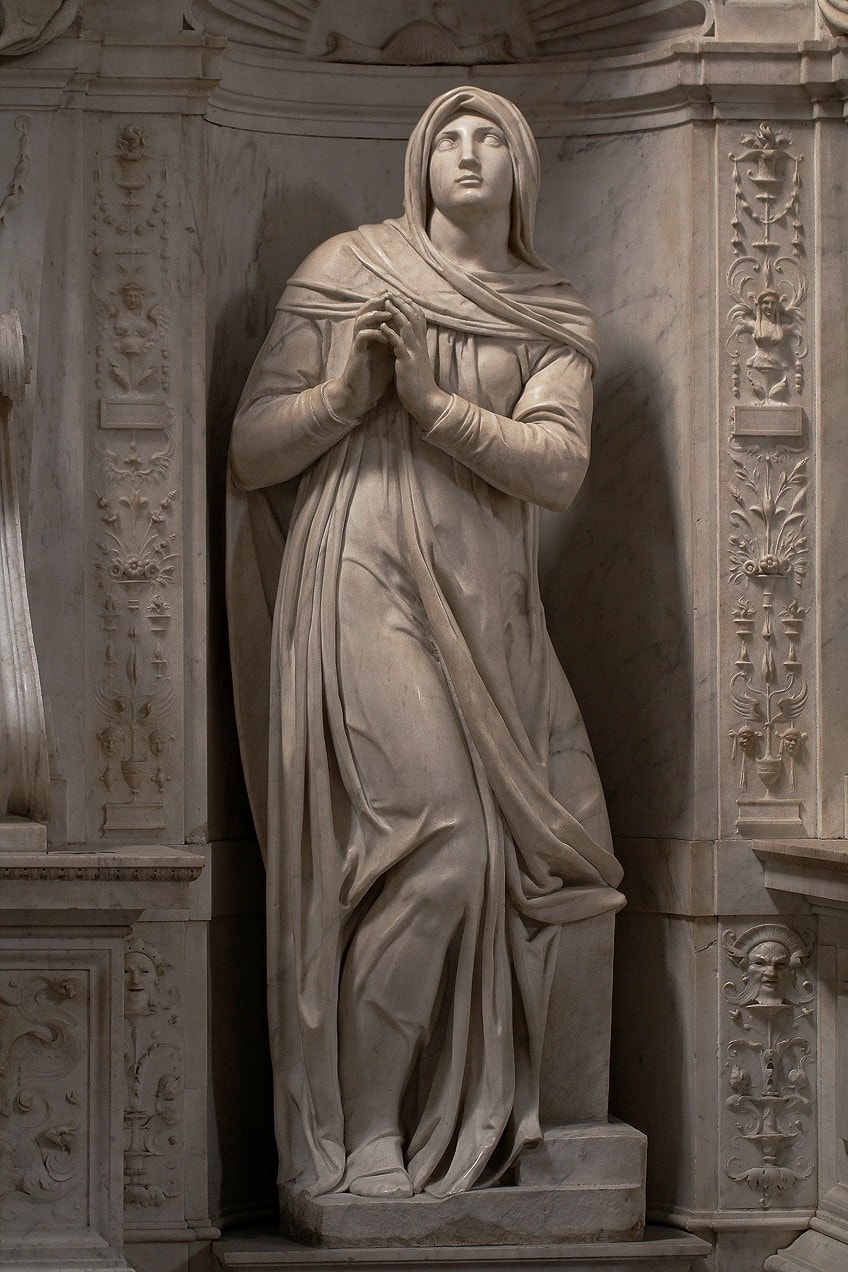
The subject of the sculpture is the Biblical figure of Rachel, from the Old Testament. This Michelangelo statue was produced for Pope Julius II’s tomb and now stands alongside Moses, (1513-1515) with Leah on the other side.
The meaning of these two sculptures has been a subject of much discussion and debate, with art historians interpreting the two as symbolic of the two alternative methods of living a fruitful life; Rachel represents a faith-based path while Leah represents a work-based.
These two sculptures and their subjects represent two different methods of living but do not directly oppose each other.
The Deposition (1547 – 1553)
| Title | The Deposition |
| Date Created | 1547-1553 |
| Medium | Marble sculpture |
| Dimensions (cm) | 277 |
| Current location | Museo dell’Opera del Duomo, Florence |
| Value | Unknown |
The deposition, which refers to Christ’s body being taken down from the cross after his crucifixion, is the subject of this sculpture. The scene, as depicted by Michelangelo, features four figures; the body of Christ, the Virgin Mary, Nicodemus, and Mary Magdalene.
The scene depicts Christ’s body falling into the arms of the Virgin Mary and Mary Magdalene, whose inclusion is especially notable, as she would usually not be included in such a piece of high importance, being somewhat of a controversial figure within the Christian and Catholic faith.

Behind them is a hooded figure, often debated to either be Nicodemus or Joseph of Arimathea. As this sculpture depicts Jesus in the arms of his mother, it is often referred to as a pietà. This piece as a sculpture is rather complex, holding layers of meaning and interpretations. As this sculpture can be referred to as The Deposition, a pietà, or even a depiction of the Entombment, (due to the presence of Nicodemus and Joseph) the multiple interpretations are emphasized in the composition.
If a viewer were to walk around the sculpture, they would be able to observe all three potential narratives from different perspectives. This piece was made this sculpture for his own tomb in Santa Maria Maggiore, Rome, beginning to work on it around the age of 72, with many scholars agreeing that Nicodemus was modeled after the artist himself.
After working on it for eight years, he attempted to destroy it out of frustration. It was eventually completed to its current state by Tiberius Calcagni.
Cupid (1556)
| Title | Cupid |
| Date Created | 1556 |
| Medium | Marble sculpture |
| Dimensions (cm) | Unknown |
| Current location | Metropolitan Museum of Art, Manhattan |
| Value | Unknown |
The Michelangelo sculpture of Cupid certainly has an interesting history. It was artificially aged to appear as an antique, which was advised to the artist by Lorenzo di Pierfrancesco. The statue depicts a curly-haired young boy with damaged limbs, carrying a quiver made from the paw of a lion. In 1955, the sculpture was displayed at a French art exhibition at the Metropolitan Museum of Art, Manhattan with no identification of the artist, when Fine Arts professor Kathleen Brandt noted that the piece had all the characteristics that defined the works of a young Michelangelo.
She noted the flick of the curly hair and the carving techniques, with an art curator named Dr. Penny suggesting that no other artist of the time would have been innovative enough to make Cupid’s quiver be made from a lion’s paw. Art historians began to examine the history of the piece to find its origins.
It was first recorded in 1556 in a house in Rome owned by Jacopo Galli, where it was named “Apollo”, likely due to the quiver. In 1650 the sculpture was said to be situated in the garden of Villa Borgheses, Rome, and had been renamed “Cupid”.
The next recorded instance of the statue’s whereabouts was in 1902 when the then-damaged piece was spotted by a dealer by the name of Stefano Bardini, who identified as a work of Michelangelo and took it to London to auction it off. The piece did not sell and was then returned to Rome, where architect Stanford White purchased it for a house he was designing for Payne Whitney.
Whitney died in 1944, with much of his art being auctioned off, but once again, the statue did not sell and remained in the house. In 1968, an Italian scholar identified the piece as a Michelangelo work. Today, the piece remains at the Metropolitan Museum, stating that the piece was indeed constructed by Michelangelo.
The Renaissance sculptures by Michelangelo discussed above show the artist’s advanced skill and technique; his signature musculature, precise carving and use of contours and shadows are the reason his works are considered masterpieces, and why his art is studied and praised to this day.
Take a look at our Michelangelo famous works webstory here!
Frequently Asked Questions
What Is Michelangelo Best Known For?
Michelangelo’s most well-known works are the statue of David (1501 – 1504), which is currently housed at the Academia di Belle Arti di Firenze in Florence, and the fresco, The Creation of Adam (1512), which is part of the ceiling of the Sistine Chapel in the Vatican City.
Where Was Michelangelo Born?
Michelangelo was born in Caprese, Florence. The village is now known as Caprese Michelangelo, named after the artist.
How Old Was Michelangelo When He Died?
Michelangelo lived from 1475 to 1564, making him 88 years old at the time of his death.
How Much Would Michelangelo Be Worth Today?
Despite previous sources reporting that the artist was not financially fortunate, the estate of Michelangelo today is worth 50,000 florins, which is worth almost $37 million today.
Isabella studied at the University of Cape Town in South Africa and graduated with a Bachelor of Arts majoring in English Literature & Language and Psychology. Throughout her undergraduate years, she took Art History as an additional subject and absolutely loved it. Building on from her art history knowledge that began in high school, art has always been a particular area of fascination for her. From learning about artworks previously unknown to her, or sharpening her existing understanding of specific works, the ability to continue learning within this interesting sphere excites her greatly.
Her focal points of interest in art history encompass profiling specific artists and art movements, as it is these areas where she is able to really dig deep into the rich narrative of the art world. Additionally, she particularly enjoys exploring the different artistic styles of the 20th century, as well as the important impact that female artists have had on the development of art history.
Learn more about Isabella Meyer and the Art in Context Team.
Cite this Article
Isabella, Meyer, “Michelangelo Sculptures – Explore the Famous Michelangelo Works.” Art in Context. May 22, 2022. URL: https://artincontext.org/michelangelo-sculptures/
Meyer, I. (2022, 22 May). Michelangelo Sculptures – Explore the Famous Michelangelo Works. Art in Context. https://artincontext.org/michelangelo-sculptures/
Meyer, Isabella. “Michelangelo Sculptures – Explore the Famous Michelangelo Works.” Art in Context, May 22, 2022. https://artincontext.org/michelangelo-sculptures/.









